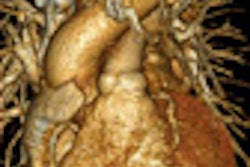Dear AuntMinnie Member,
The growth of virtual colonoscopy is part of a larger revolution in gastrointestinal imaging driven by new exam techniques and the improved image quality of today's multidetector-row CT and high-field MRI scanners. The impact of VC, and that of other gastrointestinal imaging exams such as CT and MR enteroclysis, is sure to grow as the exams become increasingly accurate in the hands of experienced radiologists.
This week in our Virtual Colonoscopy Digital Community, we're pleased to present several excerpts from a new resource on gastrointestinal imaging technologies, including virtual colonoscopy. Entitled Atlas of Gastrointestinal Imaging: Radiologic-Endoscopic Correlation (Saunders Elsevier, 2007), the book was authored by two prominent abdominal radiologists, Dr. Perry J. Pickhardt and Dr. Glen M. Arluk.
Our excerpts include sections covering imaging of the mesenteric small bowel, colon and rectum, as well as a nearby organ, the pancreas. Each section also includes image galleries -- with over 160 images in all -- correlating the radiologic and endoscopic studies. Just click here to begin viewing the excerpts.
When you're done, check out a new story in the community on a relatively recent virtual colonoscopy reading technique called filet view. The method uses software to "unroll" VC images into a flattened view that some clinicians believe can help minimize the impact of blind spots created by structures in the colon.
Korean researchers recently put a filet view technique through its paces, with the goal of seeing whether the method could streamline study review times. Find out what they discovered by clicking here, or visit our Virtual Colonoscopy Digital Community, at vc.auntminnie.com.




















